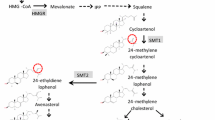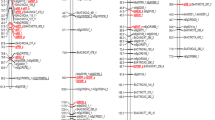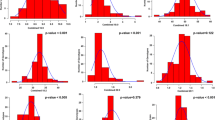Abstract
Oil content in rapeseed (Brassica napus L.) is generally regarded as a character with high heritability that is negatively correlated with protein content and influenced by plant developmental and yield related traits. To evaluate possible genetic interrelationships between these traits and oil content, QTL for oil content were mapped using data on oil content and on oil content conditioned on the putatively interrelated traits. Phenotypic data were evaluated in a segregating doubled haploid population of 282 lines derived from the F1 of a cross between the old German cultivar Sollux and the Chinese cultivar Gaoyou. The material was tested at four locations, two each in Germany and in China. QTLMapper version 1.0 was used for mapping unconditional and conditional QTL with additive (a) and locus pairs with additive × additive epistatic (aa) effects. Clear evidence was found for a strong genetic relationship between oil and protein content. Six QTL and nine epistatic locus pairs were found, which had pleiotropic effects on both traits. Nevertheless, two QTL were also identified, which control oil content independent from protein content and which could be used in practical breeding programs to increase oil content without affecting seed protein content. In addition, six additional QTL with small effects were only identified in the conditional mapping. Some evidence was apparent for a genetic interrelationship between oil content and the number of seeds per silique but no evidence was found for a genetic relationship between oil content and flowering time, grain filling period or single seed weight. The results indicate that for closely correlated traits conditional QTL mapping can be used to dissect the genetic interrelationship between two traits at the level of individual QTL. Furthermore, conditional QTL mapping can reveal additional QTL with small effects that are undetectable in unconditional mapping.
Similar content being viewed by others
Reference
Atchley WR, Zhu J (1997) Developmental quantitative genetics, conditional epigenetic variability and growth in mice. Genetics 147:765–776
Axelsson T, Shavorskaya O, Lagercrantz U (2001) Multiple flowering time QTLs within several Brassica species could be the result of duplicated copies of one ancestral gene. Genome 44:856–864
Becker HC, Löptien H, Röbbelen G (1999) Breeding: an overview. In: Gomez-Campo C (ed) Biology of Brassica coenospecies. Elsevier, Amsterdam, pp 413–460
Butruille DV, Guries RP, Osborn TC (1999) Linkage analysis of molecular markers and quantitative trait loci in populations of inbred backcross lines of Brassica napus L. Genetics 153:949–964
Cao GQ, Zhu J, He CX, Gao YM, Yan JQ, Wu P (2001) Impacts of epistasis and QTL × environment interaction for developmental behavior of plant height in rice (Oryza sativa L.). Theor Appl Genet 103:153–160
Cheung WY, Landry BS (1998) Molecular mapping of seed quality traits in Brassica juncea L. Czern. and Coss. Proc. Int. Symp on Brassica. Acta Hort 459:139–147
Ecke W, Uzunova M, Weißleder K (1995) Mapping the genome of rapeseed (Brassica napus L.). II. Localization of genes controlling erucic acid systhesis and seed oil content. Theor Appl Genet 91:972–977
Ferreira ME, Satagopan J, Yandell BS, Williams PH, Osborn TC (1995) Mapping loci controlling vernalization requirement and flowering time in Brassica napus. Theor App Genet 90:727–732
Grami B, Stefansson BR (1977) Genetics of protein and oil content in summer rape. Heritability, numbers of effective factors, and correlations. Can J Plant Sci 57:937–943
Gül MK (2002) QTL-Kartierung und Analyse von QTL × Stickstoff Interaktionen beim Winterraps (Brassica napus L.). Cuvillier Verlag, Göttingen
Gül M, Becker HC, Ecke W (2003) QTL mapping and analysis of QTL × nitrogen interactions for protein and oil contents in Brassica napus L. In: Proceedings of the 11th international rapeseed congress, Copenhagen, Denmark, pp 91–93
Guo LB, Xing YZ, Mei HW, Xu CG, Shi CH, Wu P, Luo LJ (2005) Dissection of component QTL expression in yield formation in rice. Plant Breed 124:127–132
Kole C, Quijada P, Michalels SD, Amasino RM, Osborn TC (2001) Evidence for homology of flowering-time genes VFR2 from Brassica rapa and FLC from Arabidopsis thaliana. Theor Appl Genet 102:425–430
Koornneef M, Hanhart CJ, Van der Veen JH (1994) A genetic and physiological analysis of late-flowering mutants in Arabidopsis. Mol Gen Genet 229:57–66
Lander ES, Botstein D (1989) Mapping mendelian factors underlying quantitative traits using RFLP linkage maps. Genetics 121:185–199
Lee SH, Bailey MA, Mian MAR, Carter TE Jr, Shipe ER, Ashley DA, Parrot WA, Hussey RS, Boerma HR (1996) RFLP loci associated with soybean seed protein and oil content across populations and locations. Theor Appl Genet 93:649–657
Leon J, Becker HC (1995) Rapeseed genetics. In: Diepenbrock W, Becker HC (eds) Physiological potentials for yield improvement of annual oil and protein crops. Blackwell Wiss Verl, Berlin, pp 53–90
Lööf B, Appelqvist LA (1972) Plant breeding for improved yield and quality. In: Appelqvist LA, Ohlson R (eds) Rapeseed: cultivation, composition, processing and utilization. Elsevier, Amsterdam, the Netherlands, pp 101–122
Mendham NJ, Salisbury PA (1995) Crop development, growth and yield. In: Kimber D, McGregor DI (eds) Brassica oilseeds: production and utilization. Cambridge University Press, Cambridges, pp 11–64
Osborn TC, Kole C, Parkin IAP, Sharpe AG, Kuiper M, Lydiate DJ, Trick M (1997) Comparison of flowering time genes in Brassica rapa, B. napus and Arabidopsis thaliana. Genetics 146:1123–1129
Röbbelen G, Thies W (1980) Biosynthesis of seed oil and breeding for improved meal quality. In: Tsumoda S, Hinta K, Gomez-Campo C (eds) Brassica crops and wild allies: biology and breeding. Japan Scientific Societies Press, Tokyo, pp 285–299
Sharma R, Mohapatra T, Mukherjee AK, Krishanpal, Sharma RP (1999) Molecular markers for seed oil content in Indian mustard. J Plant Biochem Biotech 8:99–102
Shi CH, Wu JG, Fan LJ, Zhu J, Wu P (2001) Developmental genetic analysis of brown rice weight under different environmental conditions in indica rice. Acta Bot Sin 43:603–609
Shoemaker RC, Polzin K, Labate J, Specht J, Brummer EC, Olson T, Young N, Concibido V, Wilcox J, Tamulonis JP, Kochert G, Boerma HR (1996) Genome duplication in soybean (Glycine subgenus soja). Genetics 144:329–338
Stefansson BR, Kondra ZP (1975) Tower summer rape. Can J Plant Sci 55:343–344
Tillmann P (1997) Recent experience with NIRS analysis of rapeseed. CGIRC Bull 13:84–87
Upadhyay A, Mohapatra T, Pai RA, Sharma RP (1996) Molecular mapping and character tagging in mustard (Brassica juncea). II: Association of RFLP markers with seed coat colour and quantitative traits. J Plant Biochem Biotech 5:17–22
Wang DL, Zhu J, Li ZK, Paterson AH (1999) Mapping of QTL with epistatic effects and QTL × environment interactions by mixed model approaches. Theor Appl Genet 99:1255–1264
Wen YX, Zhu J (2005) Multivariable conditional analysis for complex trait and its components. Acta Genet Sin 32:289–296
Wu RL, Ma CX, Zhu J, Casella G (2002) Mapping epigenetic quantitative trait loci (QTL) altering a developmental trajectory. Genome 45:28–33
Yan JQ, Zhu J, He CX, Benmoussa M, Wu P (1998a) Quantitative trait loci analysis for developmental behavior of tiller number in rice (Oryza sativa L.). Theor Appl Genet 97:267–274
Yan JQ, Zhu J, He CX, Benmoussa M, Wu P (1998b) Molecular dissection of developmental behavior of plant height in rice (Oryza sativa L.). Genetics 150:1257–1265
Ye ZH, Lu ZZ, Zhu J (2003) Genetic analysis for developmental behavior of some seed quality traits in upland cotton (Gossypum hirsutum L.). Euphytica 129:183–191
Zhao J, Becker HC, Zhang D, Zhang Y, Ecke W (2005) Oil content in an European × Chinese rapeseed population: QTL with additive and epistatic effects and their genotype-environment interactions. Crop Sci 45:51–59
Zhu J (1992) Mixed model approaches for estimating genetic variance and covariance. J Biomath 7:1–11
Zhu J (1995) Analysis of conditional genetic effects and variance components in developmental genetics. Genetics 141:1633–1639
Acknowledgements
We are grateful to Prof. Dr. Jun Zhu, Institute of Biomathematics, Zhejiang University, China for his valuable suggestions on conditional QTL mapping and for providing the software and facilities during data analysis. We thank Joerg Schondelmaier at Saaten-Union Resistenzlabor GmbH, Hovedissen, Germany, for his contribution to the marker analysis. This research was financially supported by the European Commission within the cooperative project IC18-CT 97-0172, the Natural Science Foundation of Zhejiang Province, China (No. Z303407) and the National Natural Science Foundation of China (No. 30470985).
Author information
Authors and Affiliations
Corresponding author
Additional information
Communicated by S. J. Knapp
Rights and permissions
About this article
Cite this article
Zhao, J., Becker, H.C., Zhang, D. et al. Conditional QTL mapping of oil content in rapeseed with respect to protein content and traits related to plant development and grain yield. Theor Appl Genet 113, 33–38 (2006). https://doi.org/10.1007/s00122-006-0267-5
Received:
Accepted:
Published:
Issue Date:
DOI: https://doi.org/10.1007/s00122-006-0267-5




